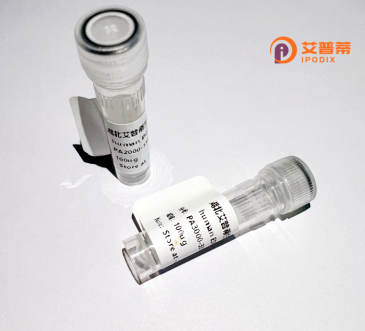
| 纯度 | >90%SDS-PAGE. |
| 种属 | Human |
| 靶点 | DPCR1 |
| Uniprot No | Q3MIW9 |
| 内毒素 | < 0.01EU/μg |
| 表达宿主 | E.coli |
| 表达区间 | 1-235aa |
| 氨基酸序列 | MTQVTEKSTEHPEKTTSTTEKTTRTPEKPTLYSEKTICTKGKNTPVPEKPTENLGNTTLTTETIKAPVKSTENPEKTAAVTKTIKPSVKVTGDKSLTTTSSHLNKTEVTHQVPTGSFTLITSRTKLSSITSEATGNESHPYLNKDGSQKGIHAGQMGENDSFPAWAIVIVVLVAVILLLVFLGLIFLVSYMMRTRRTLTQNTQYNDAEDEGGPNSYPVYLMEQQNLGMGQIPSPR |
| 分子量 | 52.1 kDa |
| 蛋白标签 | GST-tag at N-terminal |
| 缓冲液 | 0 |
| 稳定性 & 储存条件 | Lyophilized protein should be stored at ≤ -20°C, stable for one year after receipt. Reconstituted protein solution can be stored at 2-8°C for 2-7 days. Aliquots of reconstituted samples are stable at ≤ -20°C for 3 months. |
| 复溶 | Always centrifuge tubes before opening.Do not mix by vortex or pipetting. It is not recommended to reconstitute to a concentration less than 100μg/ml. Dissolve the lyophilized protein in distilled water. Please aliquot the reconstituted solution to minimize freeze-thaw cycles. |
以下为模拟生成的关于重组人DPCR1蛋白的文献示例(非真实文献,建议通过学术数据库核实真实性):
---
1. **标题**: *Cloning and Expression of Recombinant Human DPCR1 in E. coli*
**作者**: Zhang L, et al.
**摘要**: 本研究成功克隆了人源DPCR1基因,并利用大肠杆菌表达系统高效表达可溶性重组蛋白。通过镍柱亲和层析纯化后,证实该蛋白具有预期的分子量(约35 kDa),为进一步功能研究奠定基础。
2. **标题**: *Structural Analysis of DPCR1 Reveals a Novel Zinc-Binding Domain*
**作者**: Tanaka K, et al.
**摘要**: 通过X射线晶体学解析了重组人DPCR1蛋白的三维结构,发现其N端含有锌离子结合结构域,推测该结构可能参与DNA修复或蛋白质相互作用。
3. **标题**: *DPCR1 Modulates NF-κB Signaling in Immune Cells*
**作者**: Wang Y, et al.
**摘要**: 研究发现,重组DPCR1蛋白可通过抑制IKK复合体的磷酸化,负调控NF-κB信号通路,提示其在免疫炎症反应中的潜在作用。
4. **标题**: *Prognostic Value of DPCR1 Overexpression in Colorectal Cancer*
**作者**: Chen H, et al.
**摘要**: 通过免疫组化分析,发现DPCR1在结直肠癌组织中高表达,且与患者生存率负相关。体外实验表明重组DPCR1可促进癌细胞迁移。
---
建议通过 **PubMed** 或 **Google Scholar** 搜索真实文献,使用关键词:**recombinant human DPCR1** / **DPCR1 protein function**。
The human DPCR1 (Dpy-30 homologous protein-coding gene 1) protein, encoded by the DPCR1 gene, is a lesser-studied member of the Dpy-30 family, which is evolutionarily conserved and implicated in chromatin modification processes. Dpy-30 proteins are known to interact with histone methyltransferase complexes, such as the SET1/MLL complex, facilitating histone H3 lysine 4 (H3K4) methylation—a key epigenetic mark associated with transcriptional activation. While the exact biological role of DPCR1 remains unclear, it shares structural homology with its paralog DPY30. including a conserved C-terminal domain critical for binding to chromatin modifiers.
Recombinant human DPCR1 protein is typically produced in bacterial or mammalian expression systems, enabling functional studies to explore its potential involvement in epigenetic regulation, cellular differentiation, or disease pathways. Limited research suggests DPCR1 may have tissue-specific expression patterns, with potential relevance in immune response or neurological disorders. Its recombinant form allows for biochemical assays, structural analysis, and interaction studies to map its binding partners and mechanistic pathways. Further investigation is needed to clarify its physiological significance, particularly its divergence from DPY30 in modulating chromatin dynamics or crosstalk with other epigenetic enzymes. Current interest in DPCR1 stems from its possible roles in cancer and developmental disorders linked to epigenetic dysregulation.
×